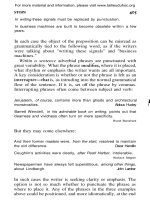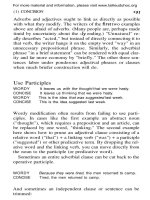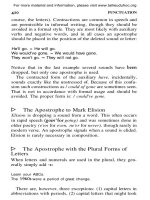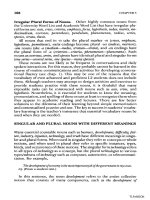Essential guide to writing part 13
Bạn đang xem bản rút gọn của tài liệu. Xem và tải ngay bản đầy đủ của tài liệu tại đây (285.46 KB, 15 trang )
THE SENTENCE
longer write like Thomas Jefferson or Samuel Johnson, we
can still use parallelism and balance as ways of organizing
some aspects of experience and knowledge, and as means of
attaining economy, emphasis, and variety in our sentences.
For Practice
The following sentences all exhibit balanced construction.
Some exhibit a simple one-to-one balance; others are more com-
plicated. Identify the general pattern of each, /
; and so on.
was enjoying the privilege of studying at the world's finest uni-
versities; Negroes at home were revolting against their miserable
Stanley Sanders
As for me, am no more yours, nor you mine. Death hath cut us
asunder; and God hath divided me from the world and you from
me. Sir Walter Raleigh
For aristocrats and adventurers France meant big money; for most
Englishmen it came to seem a costly extravagance.
Geoffrey
Then she shrieked shrilly, and fell down in a swoon; and then
women bare her into her chamber, and there she made overmuch
Sir Thomas Malory
Heaven had now declared itself in favour of France, and had laid
bare its outstretched arm to take vengeance on her invaders.
David Hume
The more we saw in the Irishman a sort of warm and weak fidelity,
the more he regarded us with a sort of icy anger.
G. K. Chesterton
Building ceases, births diminish, deaths multiply; the nights
lengthen, and days grow shorter. Maurice Maeterlinck
In a few moments everything grew black, and the rain poured down
like a cataract. Francis
For more material and information, please visit www.tailieuduhoc.org
SENTENCE STYLES
He could not keep the masses from calling him Lindy, but he con-
vinced them that he was not the Lindy type. John
In literature there is no such thing as pure thought; in literature,
thought is always the handmaid of emotion. Murry
Choosing different subjects from those in the text, compose five
balanced sentences modeled upon examples in the preceding
question.
The Subordinating Style
The sentence styles we have looked at thus
freight-train, cumulative, parallel, and similar
in one essential: all treat their constituent ideas as more or less
equally important. In much composition, however, it is nec-
essary to show degrees of significance. This calls for a differ-
ent principle of structure: subordination. Subordination
means focusing on one idea (expressed in the main clause) and
arranging points of lesser importance around it, in the form
of phrases and dependent clauses.
There are four basic variations of the subordinating sen-
tence, depending on the relative positions of the main clause
and the subordinate constructions:
Loose structure: the main clause comes first and is followed by
the subordinate clauses and phrases.
2. Periodic structure: the subordinate constructions precede the
main clause, which closes the sentence.
3. Convoluted structure: the main clause is split in two, opening
and closing the sentence; the subordinate constructions intrude
between the parts of the main clause.
4. Centered structure: the main clause occupies the middle of the
sentence and is both preceded and followed by subordinate
constructions.
The four patterns may be mixed in varying degrees and fre-
quently are. Even so, it is probably true that most subordinate
sentences follow one pattern or another.
For more material and information, please visit www.tailieuduhoc.org
THE SENTENCE
The Loose Sentence
At its simplest the loose sentence contains a main clause plus
a subordinate construction:
We must always be wary of conclusions drawn from the ways of
the social insects, since their evolutionary track lies so far from
Ours. Robert
The number of ideas in loose sentences is easily increased by
adding phrases and clauses, related either to the main con-
structions or to a preceding subordinate one:
found a large hall, obviously a former garage, dimly lit, and
packed With COtS.
knew had found a friend in the woman, who herself was a lonely
soul, never having known the love of man or child.
Emma Goldman
As the number of subordinate constructions increases, the
loose sentence approaches the cumulative style (discussed on
pages It is impossible to draw a line between loose
and cumulative sentences. Indeed, cumulative sentences (or
rather, most of them) are a special variety of the loose style.
The difference is relative, depending on the length and weight
of the subordinate constructions. In the cumulative sentence
these take over, becoming more than the main
clause, which serves primarily to introduce them. The follow-
ing passage describing a Welsh town illustrates how loose
structure evolves into a cumulative style:
hangs pleasantly, with its white cottages, and orchard
and other trees, on the western slope of a green hill; looking far
and wide over green meadows and little or bigger hills, in the pleas-
ant plain of Glamorgan; a short mile to the south of Cowbridge, to
which smart little town it is properly a kind of suburb.
Thomas Carlyle
For more material and information, please visit www.tailieuduhoc.org
SENTENCE STYLES
Loose sentences are appropriate for writing that aims to be
colloquial, informal, relaxed. It puts first things first, as most
of us do when we talk. On the other hand, loose structure
lacks emphasis and easily becomes formless. Its unity derives
not so much from a structural principle as from the coherence
of thought. A loose sentence is well formed to the degree that
it expresses a completed idea or perception. A good example
is the following passage, which begins a description of the
Brooklyn home belonging to the writer's grandmother:
Her house was a narrow brownstone, two windows to every floor
except the ground, where the place of one window was taken by
a double door of solid walnut plated with layers of dust-pocked
cheap enamel. shallow stoop.... William Alfred
Alfred's sentence is unified by what it facade
of the house. When that perception ends and our eyes are
turned upon the stoop, the writer wisely begins a new sen-
tence. Of course, this question of when to stop, of knowing
when one statement should end and another begin, applies to
all kinds of sentences. But it causes special problems with
loose structure, where the absence of a clear stopping place
may tempt you to ramble on and on.
The Periodic Sentence
Periodic sentences reverse the pattern of loose structure, be-
ginning with subordinate constructions and putting the main
clauses at the end:
there is no future for the black ghetto, the future of all Negroes
is diminished. Stanley Sanders
Given a moist planet with methane, formaldehyde, ammonia, and
some usable minerals, all of which abound, exposed to lightning
or ultraviolet radiation at the right temperature, life might start al-
most anywhere. Lewis Thomas
For more material and information, please visit www.tailieuduhoc.org
THE SENTENCE
There is no one formula for the periodic sentence. Often,
however, the opening subordinate constructions are adverbial
clauses, as in the example by Stanley Sanders, or participial
phrases, as in that by Lewis Thomas.
Whatever kinds of subordination it uses, the periodic style
is emphatic. Delaying the principal thought increases its im-
portance. To the degree that more and more subordinate
clauses and phrases are accumulated at the beginning, further
postponing the main clause, the sense of climax increases
(within limits, of course; too long a delay will cause confu-
sion). Here is an instance of effectively postponing the main
point:
Paralyzed by the neurotic lassitude engendered by meeting one's
past at every turn, around every corner, inside every cupboard, go
aimlessly from room to room. Joan Didion
The periodic style is also more formal and literary than the
loose, suggesting a writer at a desk rather than a speaker in a
relaxed social setting, a tone advantageous on formal occa-
sions, though less so when informality is desired.
The Convoluted Sentence
In this type of periodic structure the subordinate elements
split the main clause from the inside, often intruding between
the subject and the verb and sometimes between verb and
object or within the verb phrase:
White men, at the bottom of their hearts, know this.
James Baldwin
And once in a spasm of reflex chauvinism, she called Queen Vic-
toria, whom she rather admired, "a goddamned old water dog."
William Alfred
Convoluted structure, as an occasional rather than habitual
style, is a good way of achieving variety in sentence move-
For more material and information, please visit www.tailieuduhoc.org
SENTENCE STYLES
It also establishes strong emphasis by throwing weight
upon the words before and after the commas or dashes setting
off the interrupting constructions:
Now demons, whatever else they may be, are full of interest.
Here both "demons" and "full of interest" draw attention,
expressing the principal idea more strongly than would loose
or periodic structure:
Now demons are full of interest, whatever else they may be.
Whatever else they may be, demons are full of interest.
However, this fact does not mean that the convoluted style is
inherently better than either the periodic or the loose. It is
simply a convenient way of establishing emphasis on partic-
ular words when that emphasis is desirable.
On the other hand, convoluted structure is formal, and it
can tax readers' attention, especially as the interrupting ele-
ments grow longer and more complicated:
Even the humble ambition, which long cherished, of making
sketches of those places which interested me, from a defect of eye
or of hand was totally ineffectual. Sir Walter Scott
The life story to be told of any creative worker is therefore by its
very nature, by its diversion of purpose and its qualified success,
by its grotesque transitions from sublimation to base necessity and
its pervasive stress towards flight, a comedy. H. c. Wells
These are good sentences, carefully articulated and precise;
but they are not easy to read. They demand attention; readers
must recognize when a construction is suspended and when
it is resumed and be able to put the pieces together. Used
sparingly, the long convoluted sentence has the virtue of the
unusual: it draws attention to itself and, more important, to
what it says, and it can challenge and stimulate the reader. A
For more material and information, please visit www.tailieuduhoc.org









